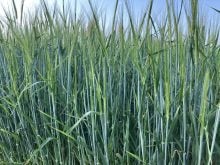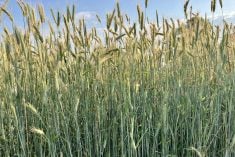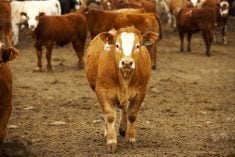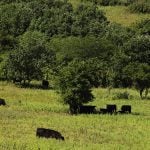Fed cattle found substantial tailwinds, making new record-high prices in March 2023. Feeder prices in the first quarter of 2023 are approaching the record highs from 2015. Strong cattle prices are being supported by tighter North American supplies. Following two years of drier conditions, Canadian and U.S. cattle inventories were lower to begin 2023. Fed cattle slaughter has tightened to be below year-ago levels but remains higher than the five-year average. Despite record-high cattle prices, margins are being squeezed by feed grain prices which have eased somewhat but remain well above historical levels.
Supply indicators
2021 drought lowers Canadian inventories
Read Also

What to know before you go to Agribition 2025
If you’re attending Agribition 2025, this is the place to find out about tickets, dates and what’s happening this year.
Total cattle and calves on January 1, 2023, were 2.2 per cent lower than in 2022, at 11.27 million head. Canadian cattle inventories have been declining steadily since 2018. Tighter North American cattle inventories have supported prices in 2023.
Nationally, the beef cow herd declined 2.5 per cent to 3.56 million head as of Jan. 1, 2023, down 4.8 per cent or 181,000 head from the 2018 peak. Beef cow herd increases occurred in the Atlantic provinces (+1.2 per cent), Quebec (+2.3 per cent), Ontario (+2.9 per cent) and Manitoba (+0.6 per cent), but declined in Saskatchewan (-1.8 per cent), Alberta (-4.8 per cent) and British Columbia (-2.5 per cent).

Replacement beef heifers declined 4.3 per cent to 551,500 head. The Atlantic provinces recorded beef replacement heifers that were eight per cent higher than last year, while Quebec had increases of 2.1 per cent. Significant declines in replacement heifers were recorded in Saskatchewan (-5.0 per cent) and Alberta (-6.2 per cent).
Looking further out, calves under 500 lbs. are down 3.9 per cent to 3.6 million head, with the West down 4.1 per cent to 2.83 million head and the East down 3.4 per cent to 772,000 head.
Feeder imports in the second half of 2022 supported beef production again. In the first half of 2022, Canada was a net feeder exporter of 24,000 head, but in the second half, we transitioned to be a net feeder importer of almost 150,000 head.

U.S. inventories contract
Total U.S. cattle inventories as of January 1, 2023, were 89.3 million head, contracting another three per cent from 2022. The U.S. herd is now in its fourth year of decline, with additional herd reductions expected this year. Current total cattle inventories are only 0.5 per cent above the 2014 low. The U.S. beef cow herd shrunk 3.6 per cent to 28.9 million head. From the highs in 2019, the U.S. beef cow herd has declined by more than nine per cent and is at its lowest level since 1962. Replacement heifers also declined, down 5.8 per cent from last year to 5.2 million head. The U.S. dairy cow herd remained steady at 9.4 million head; however, dairy replacement heifers are down two per cent.
Steers over 500 lbs. were down 3.4 per cent from last year at 16.1 million head, and other heifers (not kept for breeding) were down 3.2 per cent to 9.7 million head. Total cattle-on-feed inventories were down 3.7 per cent to 14.2 million head. Smaller fed supplies will reduce beef production in the first half of the year.
The combined total of calves under 500 lbs. and other heifers and steers outside feedlots over 500 lbs. were down three per cent at 25.3 million head. The 2022 calf crop was down two per cent to 34.5 million head. Considering the drop in cow herd numbers, this is not surprising. Smaller calf and feeder supplies outside of feedlots will further reduce production in the second half of 2023.

Beef production peaks
Total beef production (domestic and live slaughter exports) in 2022 was 3.62 billion pounds, the highest since 2008. This was up 2.3 per cent from 2021 and up nine per cent from the five-year average. Non-fed production (domestic and exported) was up 3.5 per cent from 2021 and up five per cent from the five-year average. Fed production (domestic and exported) was up 2.2 per cent from 2021 and up 10 per cent from the five-year average. Fed carcass weights climbed higher, with average steer weights up 10 lbs. to 930 lbs. and heifers up two pounds to 843 lbs.
Carcass quality improved in 2022, with AAA and Prime grading as a percentage of all A grades at 75 per cent, up from 71.5 per cent in 2021.
To the week ending March 25, 2023, domestic beef production was steady with last year. Slaughter numbers in 2023 have been driven by non-fed cattle, up 13 per cent. Particularly in the West (up 18 per cent), while Eastern non-fed slaughter was down one per cent. Western-fed slaughter is two per cent lower than the same time last year and Eastern-fed slaughter is seven per cent lower. Heavier steer carcass weights have been offsetting fewer fed cattle and supporting production numbers.
Canadian slaughter was running on all cylinders in 2022, with federally inspected packer utilization at 94 per cent. In the West, utilization averaged 96 per cent, and in the East 87 per cent. Western packing plants had 19 weeks where slaughter was over 100 per cent, indicating Saturday shifts were run to keep up with supplies. Any reductions in slaughter in 2023 will still have utilization levels well above the 10-year average.

Cattle-on-feed tightens
Cattle-on-feed inventories have been tightening, with inventories below year-ago levels since last August. On March 1, they were 5.4 per cent lower than last year but 2.4 per cent higher than the five-year average. Heifer placements were down slightly from the 2022 highs in January and February 2023, but they are still above the five-year average. High live cattle prices on the CME continue to encourage heifer placements.
Demand indicators
The Canadian Retail Beef Demand Index (2000 = 100) increased a slight 0.5 per cent in 2022, to 122 points and is the third highest since 1990. The International Demand Index (2000 = 100) dropped 2.7 per cent in 2022 but remains historically high at 165 points. Domestic and international demand has been resilient with consumers willing to put beef on their plates. Most Canadian beef is sold in the North American market where food expenditures are a relatively small portion of their income. But price adjustments are not done.
Food inflation pushes protein prices
Retail beef prices in 2022 averaged $19.74/kg, up almost eight per cent from 2021. In January 2023, retail beef prices increased further to $20.55/kg and are almost identical to January 2022’s high levels. As retail beef prices stay historically high, maintaining relative prices with substitutes is important to prevent switching.
In the first quarter of 2022, beef/pork and beef/chicken price ratios shot up to 2.16:1 and 2.31:1, respectively. Price ratios then fell in line and moved in tandem with each other for the second half of the year, averaging 1.91:1 for pork and 1.95:1 for chicken. The combination of high retail beef prices and post-holiday sales of both pork and chicken increased the ratios in January 2023 to 2.23:1 for pork and 2.12:1 for chicken. We will be looking for price corrections in the second quarter, similar to last year.
Trade values reach new highs
Canadian exports in 2022 were up 1.4 per cent in volume and 5.1 per cent in value from 2021 to total 511,027 tonnes valued at $4.68 billion. Export volumes in 2022 were only two per cent below the 2002 high. Export values reached new record highs in 2022.

Export volumes increased to the U.S. (+2.0 per cent), Mexico (+13.4 per cent), Japan (+16.7 per cent), South Korea (+48.4 per cent), Southeast Asia including Taiwan (+11 per cent), and the Middle East and North Africa (MENA) (+65.2 per cent), but declined to Hong Kong and Macau (-36.5 per cent) and China (-99.4 per cent). Exports were affected in the last part of 2022 by fluctuations in the exchange rate. As consumers around the world face food price inflation, expectations are for greater sensitivity to exchange rate moves and their effects on price for importing countries.
Canadian imports in 2022 were up 3.8 per cent in volume and 15.9 per cent in value from 2021 to total 167,713 tonnes, valued at $1.65 billion. Import volumes increased from the U.S. (+0.9 per cent), Australia (33.7 per cent), EU 27 and the U.K. (+16.1 per cent) and Mexico (+7.0 per cent), but declined from New Zealand (-13.9 per cent), and Uruguay (-19.4 per cent). With cattle herd contractions in the U.S., and Brazilian beef again being exported to China, Canadian import volumes from major suppliers are expected to decline.
Cattle prices setting new highs
Strong spring rally for fed cattle
Alberta fed steers climbed slowly but steadily throughout 2022, closing December at $184/cwt live, 15 per cent higher than January. Ontario fed steers were more inconsistent in their climb, but ended 2022 at $191/cwt, 10 per cent higher than January. Both Alberta and Ontario fed steers have maintained that momentum into 2023, pushing the $200/cwt mark. By mid-March, new record-high prices for fed steers and heifers in both Alberta and Ontario were set. In the first quarter, Alberta fed prices rallied 15 per cent with only 2011, 2010, 1992, 1979 and 1978 having larger rallies over the same period.
Ontario fed steers were priced at a $7/cwt premium to Alberta fed steers in December. By February 2023, the premium had closed to $3/cwt.

The Alberta to Nebraska cash-to-cash basis was historically weak in the fourth quarter of 2022, averaging -$26/ cwt. The basis started to strengthen in January and aver- aged -$14/cwt in March. The Ontario to Nebraska cash-to- cash basis fared only slightly better, averaging -$23/cwt in the fourth quarter, but strengthened to -$9/cwt in March. In weak basis years, basis levels tend to be on average for the summer months but significantly weaker in the first and fourth quarters.
Despite record-high prices, feedlot margins continue to be squeezed by high feed grain prices. The Canfax Trends report estimates feedlot margins on the cash market, for yearling steers and heifers placed in September and sold in March 2023, of -$45 to -$205 per head. At higher prices, the risk faced is greater. Hence, a shift to more forward con- tracts has been notable since the fourth quarter of 2022.
Cow prices climbing
Alberta D2 cows traded largely along historical trends in the fourth quarter, although at a considerable premium to the five-year average, ranging from $85-$89/cwt. By February 2023, D2 cows shot up to $105/cwt, a 28 per cent premium to last year and a 25 per cent premium to the five-year average.
Ontario D2 cows traded at a $6-8/cwt premium to Alberta D2 cows in November and December, before fall- ing to a $1/cwt discount in January. By February, D2 cow prices were again at a $5/cwt premium averaging $110/cwt. Ontario D2 cow prices in February were 25 per cent higher than last year and a substantial 51 per cent higher than the five-year average.
Despite the strength in the Canadian cull cow market, both Alberta and Ontario D2 cows were trading at a dis- count to U.S. utility cows. U.S. utility cows were CDN$117/cwt in February, a $12/cwt premium to Alberta D2 cows and a $7/cwt premium to Ontario D2 cows.

Feed grains ease lower
Lethbridge barley has been steadily declining in value since the beginning of 2023 and is down $33/tonne to $415/ tonne. Lethbridge barley is still 37 per cent higher than the five-year average. Ontario corn trended steadily through January and February, in the $333/tonne range, averaging eight per cent higher than last year and a substantial 42 per cent higher than the five-year average. Ontario corn then dropped to below year-ago levels in March, in contrast to historical prices that have been steady to stronger. Omaha corn was mostly steady through January and February at US$7/bu. before softening in March to around US$6.50/bu.
The March grains and oilseeds outlook released by AAFC projects Canadian barley production for the 2023-24 crop year to be steady with last year at 9.8 million tonnes. Barley ending stocks are projected to be 100,000 tonnes higher than last year. Corn production is projected to be down 4.7 per cent to 13.8 million tonnes. Corn ending stocks are projected to be down 200,000 tonnes. The Canadian barley stocks-to-use ratio is expected to improve from 15 per cent in 2022-23 to 20 per cent in 2023-24. The corn stocks-to- use ratio is expected to drop one per cent to 16 per cent, despite what appears to be improvements in the Canadian feed grain supply situation. Overall, price relief on the grain side largely depends on a large U.S. corn crop this summer.

Feeder prices rise in Q1
Alberta 550-lb. steers averaged $270/cwt in the fourth quarter, 28 per cent higher than the previous year. Alberta 750-lb. steers followed suit, averaging $245/cwt, also up 28 per cent. Between December and February, 550-lb. steers climbed another 13 per cent to average $311/cwt. Alberta 750-lb. steers averaged $264/cwt in February, up eight per cent from December. In March, 550 lb. steers reached $328/ cwt and 750-lb. steers were $282/cwt.
Ontario 550-lb. steers averaged $267/cwt in the fourth quarter, 25 per cent higher than the previous year. Ontario 750-lb. steers followed suit, averaging $235/cwt, also up 25 per cent. Between December and February, 550-lb. steers climbed another 9.5 per cent to average $300/cwt. Ontario 750-lb. steers averaged $264/cwt in February, up 10 per cent from December. In March, 550-lb. steers reached $332/ cwt and 750-lb. steers were $286/cwt.

Replacement ratios
The lower the replacement ratio, the fewer dollars are required from the sale of a fed animal to purchase a replacement feeder animal. A higher ratio means that more dollars are required. Higher replacement ratios also imply lower feedlot profitability as more money is spent on replacement animals.
From Q4 2022 to Q1 2023, replacement ratios in the West increased for 550-lb. steers (+7.0 per cent), 750-lb. steers (+11 per cent), 850-lb. steers (+4.0 per cent), and 450-lb. heifers (+1.0 per cent), but declined for 650-lb. heifers (-3.0 per cent). In the East, replacement ratios were inconsistent. Ratios increased for 750-lb. steers (+2.0 per cent), 850-lb. steers (+2.0 per cent), and 450-lb. heifers (+3.0 per cent). Ratios declined for 550-lb. steers (1.0 per cent) and 650-lb. heifers (-4.0 per cent).

















